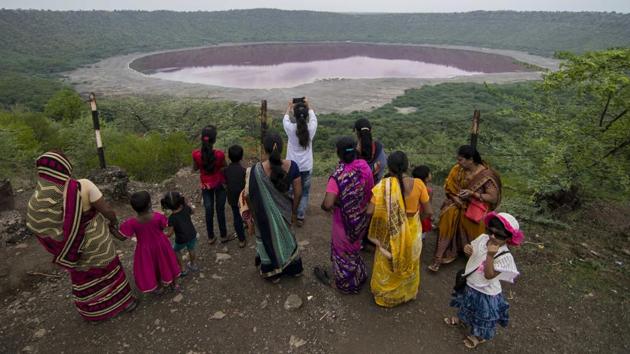Buldhana’s Lonar Lake declared Ramsar site, second for Maharashtra within a year
Inclusion will ensure added funds and training for the maintenance of the site for the staff and indigenous people
The Lonar lake in Buldhana district of Maharashtra has been declared as the 41st “Ramsar” site of India. It has effectively become the second Ramsar site in the state. There are 2,412 designated Ramsar sites in the world.

The United Nations Educational, Scientific and Cultural Organization (UNESCO) Convention for the conservation of wetlands was called the ‘Convention on Wetlands of International Importance especially as Waterfowl Habitat’. The convention got its name of Ramsar Convention from the city of Ramsar in Iran where it was signed in 1971 and came into force in 1975.
“I’m glad that the Lonar crater is now officially a Ramsar Site. Having seen it for the first time in 2004, it is a sight that captivates everyone. It has its own significance in the world of biodiversity, tourism and geology,” tweeted Aditya Thackeray, environment and tourism minister of Maharashtra.
“Inhabiting the site are 160 species of birds including the vulnerable Asian woolly neck (Ciconia episcopus) and common pochard (Aythya ferina), 46 species of reptiles, and 12 species of mammals including the iconic grey wolf (Canis lupus),” reads the announcement by Ramsar Convention.
According to the Ramsar Convention, the ecology, botany, zoology, limnology or hydrology of the wetland needs to be considered before including it in the list. The inclusion will ensure added funds and training for the maintenance of the site for the staff and indigenous people.
However, ecologist and academic Madhav Gadgil is sceptical about the development. He urged the government to first take steps at the local level failing which international intervention like Ramsar list may not help.
“These protections need to be brought to life. For example, UNESCO heritage site Kaas plateau has been made worse after being declared a heritage site. I have never seen even one site which has gained an advantage after being protected by the forest department. At Lonar, the sewage is let into the lake. There are red algae blooms - it is getting spoiled. Tourism is also highly politicised. If we have to fix this then, we must take out the tourist lodges near the heritages sites and prevent sewage from entering the lake. Where is the political will for doing all this? Rivers like Mutha and Bhima have also turned into gutter Gangas. What’s the use of giving international status? Maharashtra and the Central government climate change ministry should take it up seriously,” said Gadgil.
“The sites are both threatened by household sewage and urban wastewater and by unsustainable tourism” reads the announcement further.
The lake had made news in August when the water in the circular-shaped lake turned pink. The phenomenon was caused by salt-loving Haloarchaea microbes which lead to pigmentation, according to a report by Agharkar Research Institute (ARI) in Pune, an autonomous body under the department of Science and Technology.
The Lonar lake was declared as the 41st Ramsar site along with Sur Saroivar or Keetham Lake in Uttar Pradesh. The first site from Maharashtra to enter the list was Nandur Madhameshwar in 2019. Uttar Pradesh has the highest contribution from India to the list with eight and Punjab has the second highest with six sites in the list.





